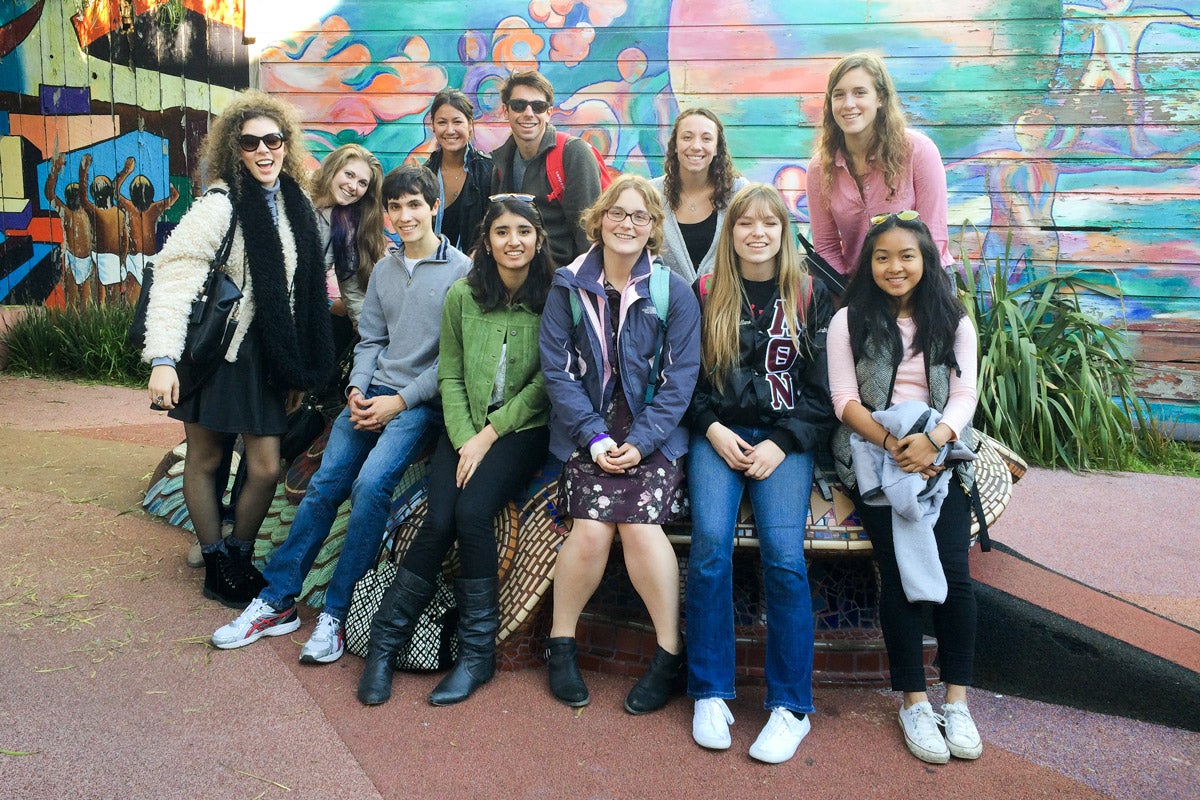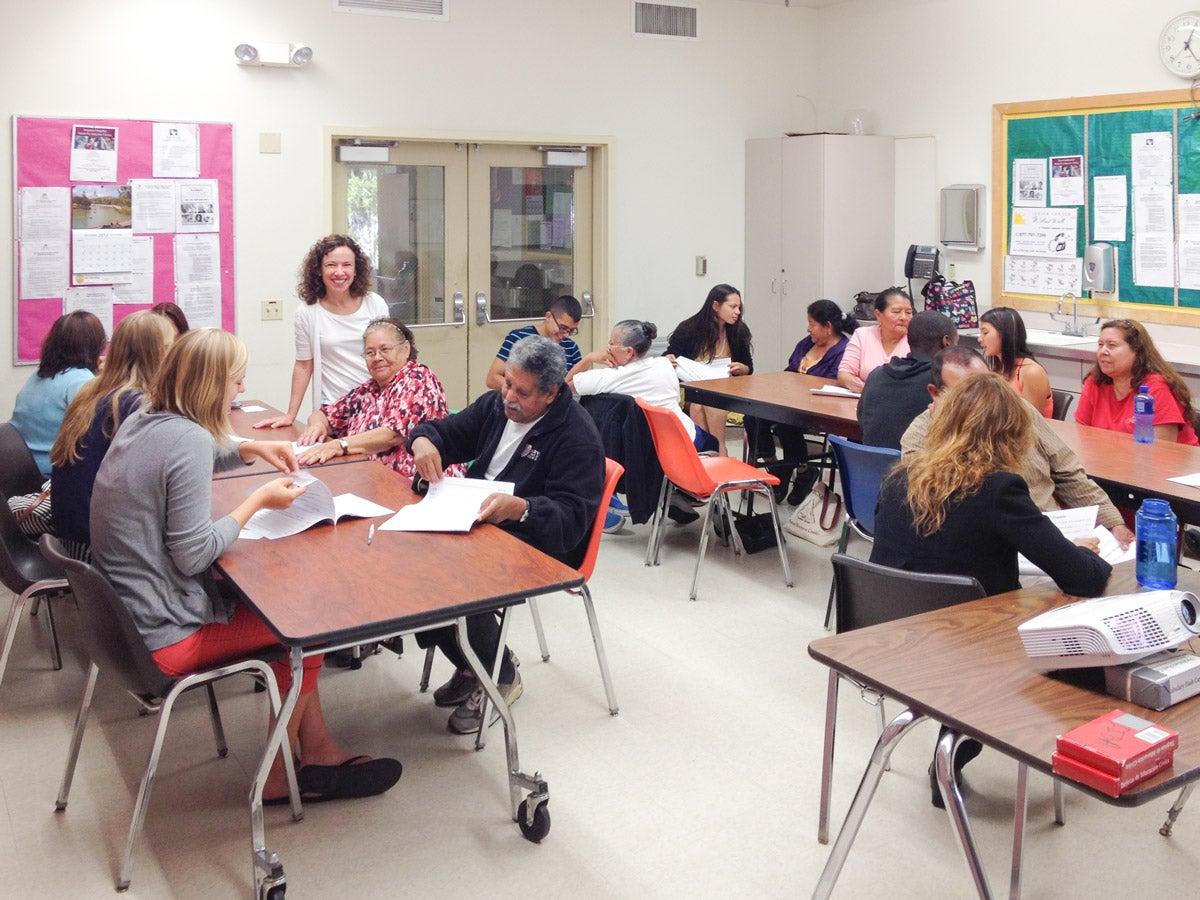Engagement with Spanish-speaking people and their cultures has been a focus of the Stanford Language Center’s Spanish language courses for years.

Stanford Spanish-language students take the Precita Eyes Muralists cultural and walking tour in San Francisco’s Mission District. (Image credit: Vivian Brates)
That commitment is evident again in a series of Cardinal Courses that combine the rigors of mastering Spanish with hands-on engagement with the Bay Area’s Spanish-speaking community.
More than 1,700 students enroll in some 130 Cardinal Courses each year as part of Stanford’s university-wide Cardinal Service initiative to apply classroom learning to real-world problems. A subset register for Community-Engaged Learning (CEL) courses offered through the Spanish language program by the Stanford Language Center.
More than 100 students and over 50 local adults have participated in the Spanish program since its inception in 2011.
Learning by doing
The ultimate goal of Cardinal Service is to make service a distinctive feature of a Stanford education. According to Paitra Houts, Stanford’s director of community-engaged learning for education, “The demand for Cardinal Courses has exploded in the past year and we hope to extend our program to even more courses, such as Introductory Seminars.”
For Ali Miano, coordinator of the Spanish program at the Language Center, “we are compañeras and compañeros” – the Spanish words for “partners” – “who show solidarity with the immigrant communities we get to know outside of the Stanford bubble.” When asked what makes a community, Miano emphasized awareness and dialogue.
“I wish Stanford students and faculty would engage more with workers on campus,” she said.
Miano hopes CEL Spanish classes will foster conversation between students and workers on campus, many of whom are native Spanish speakers. A community engagement option is now available in the third-year language sequence, where students can craft multimedia histories based on interviews with Spanish-speaking workers at Stanford. This program will be offered every quarter.
“In recording testimonios of life experiences that they may wish to share, workers impart advice, remembrances and words of wisdom while students hone proficiency in narration and description – key skills at this stage of language development,” Miano said. “Both groups develop print and digital literacies.”
Educating world citizens through community
Vivian Brates, a lecturer at the Language Center, teaches a second-year CEL course on immigration that incorporates readings and films in Spanish, as well as interpersonal contact with Spanish speakers in the Bay Area. A recent speaker in her course was Inmar A. Liborio, vice president of the Northern California union of cleaning workers, which represents approximately 2.5 million custodians. Liborio, who is also a custodian at Stanford, discussed the union’s efforts to protect workers in the region.

Stanford Sophomore College students work with immigrants studying for the citizenship exam at the International Institute of the Bay Area in Redwood City. (Image credit: IIBA)
Liborio said he has made it a priority “to try and convince other vulnerable workers, such as young women working for private employers as domestic helpers, to join our union so we can better serve their interests in the long term.”
Students asked him questions about collective contracts, legislation against sexual harassment, the union’s hopes for the future and how they can help. According to Liborio, Stanford student activists have been consistently supportive of the union’s efforts to protect workers.
Kelley Gomez, senior and CEL coordinator for Spanlang 13SL, said that community-engaged Spanish courses not only offer opportunities to practice Spanish out in the real world, but also help students “gain awareness of the immigrants’ invisible presence,” whether on or off campus.
“This is a class filled with beautiful stories and beautiful people that we never get to hear about,” she said. “It is the opportunity of a lifetime to pull back the veil we tend to keep in place.”
Students in Brates’ course also help immigrants at the International Institute of the Bay Area (IIBA) in Redwood City to study for the citizenship exam, composed of 100 questions in Spanish about American history and civics. For Alexis Kallen, a junior majoring in political science, this class has “made me aware of my privilege of having a U.S. passport.”
At the American Council on the Teaching of Foreign Languages convention in November in Boston, Brates accepted a Global Engagement Initiative Recognition Award on behalf of the Stanford Language Center for developing the partnership between the Language Center and the IIBA.
A hands-on method of learning language
Students in CEL courses also engage with Spanish-speaking artists. Irene Carvajal, a Costa Rican-American artist, spoke about Mexican muralism in Miano’s CEL course. Sitting alongside middle schoolers at the local Boys and Girls Club of the Peninsula (BGCP), Stanford students in this second-year course learned about José Clemente Orozco, Diego Rivera and David Alfaro Siqueiros, as well as the Mujeres Muralistas (“Women Muralists”) from the U.S. Chicano movement.
“Middle-schoolers are very receptive to having conversations about the value of art. Art lends itself to both serious and fun activities,” said Iain Epsey, a junior majoring in philosophy. Epsey, who said he usually works with the quietest child in the corner, relished listening to the children’s stories.
The final project of the course has Stanford and BGCP students design and paint a mural inspired by stories of their communities. Their joint effort, in Carvajal’s words, is evidence that “we are all threads in the same quilt.”
Down the road, at East Palo Alto Academy, Stanford students in Citlalli Del Carpio’s CEL course learned about environmental activism, recycling and art alongside Spanish-speaking high schoolers, most of whom migrated to the United States on their own from Honduras and El Salvador.
Over Skype, Andrea Ixchiu, a Guatemalan K’iche’ activist, explained how the indigenous local government in Totonicapán protects the environment according to the K’iche’ worldview.
“For us, water, air and land are not resources to be consumed, but are living beings,” she said.
Del Carpio emphasized the practical, hands-on component of her class focused on environmental activism via art.
“My students can see the fruit of their labor in real time,” she said. “They can connect with Spanish-speaking teenagers [and] are involved in active, project-based learning that culminates in a community art project. Ultimately, they come out with a toolbox that will elevate their engagement not only with these communities in the Bay Area but with the rest of the world.”